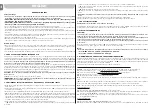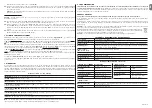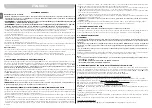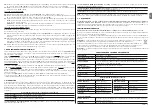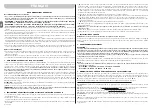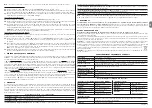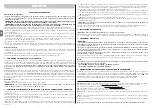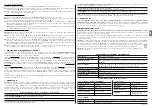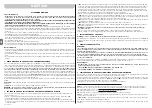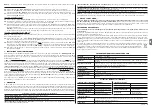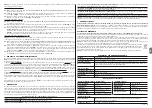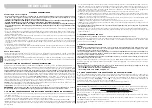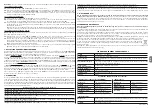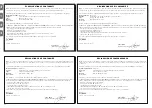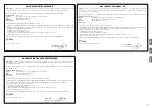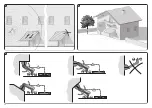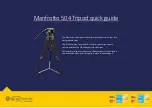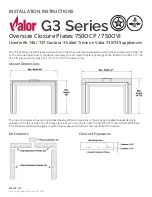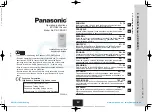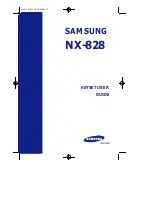
and that Nemo activates an Ascent command (
).
03.
At this point, stop the blades and check whether the
red
LED emits a series of short alternating
red
and
green
flashes: these indicate that the awning is free from the wind protection and can be controlled according to the times
set on the automation.
Caution!
– the automation may be set with control disable times. These can be deleted by switching the automa-
tion off and then back on.
RAIN SENSOR TEST (
fig. 10
):
Caution
– During rain detection the sensor is heated, so it is perfectly normal to feel heat during the procedure
described in point 02;
01.
Turn the “Sun” or “Wind” knob (
fig. 8
) ANTICLOCKWISE to the “Test” position. If you turn the “Sun” knob it is advis-
able to cover the sun sensor to prevent the sun test from affecting the rain test.
02.
Place your finger on the rain sensor (
fig. 8
) and hold it there for 3 seconds. Check that the LED emits a series of
short
yellow
flashes and that Nemo sends a “rain presence” command. The controlled device will behave accord-
ing to how it has been programmed (refer to its instruction manual).
Note
– If this does not occur, repeat this pro-
cedure.
03.
Remove your finger from the rain sensor and after 3 seconds check that the LED produces a series of short
green
flashes followed by a series of short
red
flashes.
6
–
CLIMATIC SENSOR ADJUSTMENT
Adjustment of the climatic sensors on the product is useful to set each one with a “
trip threshold
”, i.e. a value over (or
below) which Nemo is activated to send a radio signal to the receiver where it is memorised.
• (
fig. 11
)
“SUN” Threshold
– The sun sensor (
b - fig. 8
) reads and takes real time measurements of sunlight intensi-
ty; when this exceeds the set threshold, Nemo sends a Down command (
) to the automation after 2 minutes.
When the intensity of the sunlight falls by a certain value below the threshold, Nemo sends information on this status to
the automation after 15 minutes. To adjust the
“sun” threshold
, turn the knob “Sun” (
fig. 8
) to the required value.
Note
– If the “Sun” knob is set to the maximum value (clockwise limit), the sun sensor is disabled.
• (
fig. 12
)
“WIND” Threshold
– The wind sensor (
a - fig. 8
) reads and takes real time measurements of the wind
speed; when this exceeds the set threshold, Nemo sends an Up command (
) to the automation.
When the action of the wind decreases and falls below the set threshold, Nemo sends information on this status to the
automation after 4 minutes.
To adjust the
“wind” threshold
, turn the knob “Wind” (
fig. 8
) to the required value.
• The rain sensor (
c - fig. 8
) has ON /OFF type operation and is non-adjustable. It sends the command when it begins
to rain or snow.
7
–
DIAGNOSTICS
It is possible to check at any time whether the intensity of the atmospheric phenomenon is below or above the set
threshold by means of the LED which indicates the operating status. During these diagnostics Nemo provides data in
real time without taking into account the standby times set for normal operation. Faults are indicated by the LED “L1” in
the order shown in Table A. If for example during normal operation the thresholds for both wind and rain are exceeded,
only the red LED will light up (wind).
Behaviour of LED “L1” and meaning
•
Red
LED lit
= Wind: the set threshold has been exceeded
•
Yellow
LED lit
= Rain: presence of rain
•
Green
LED lit
= Sun: the set threshold has been exceeded
• Intermittent
red
LED (intervals of 0.5 seconds)
= Pre-alarm – fault on “wind” sensor: this has not detected wind
action in the last 24 hours
• Intermittent
yellow
LED (intervals of 0.5 seconds)
= Pre-alarm – fault on “rain” sensor: this has not detected rain in
the last 30 days
• Intermittent
green
LED (intervals of 0.5 seconds)
= Pre-alarm – fault on “sun” sensor: this has not detected any
variation in sunlight intensity in the last 24 hours
• LED off =
No threshold has been exceeded and there is no pre-alarm in progress
Note
– To check whether a fault is effectively present on the device, simply perform the Tests specified in Chapter 5. If
the red, yellow or green LEDs continue to emit intermittent flashes, there is probably a fault.
8
–
TROUBLESHOOTING
If the intensity of the wind or sun exceeds the set threshold or it is raining but the automation does not appear
to perform the manoeuvre correctly,
check that Nemo is powered correctly and correctly memorised on the receiver
of the automation to be controlled (see chapter 5). If this does not solve the problem, ensure correct operation of Nemo
by performing diagnostics as described in chapter 7.
PRODUCT DISPOSAL
This product is an integral part of the automation and therefore must be disposed of along with it.
As in installation, also at the end of product lifetime, the disassembly and scrapping operations must be performed by
qualified personnel.
This product is made of various types of material, some of which can be recycled while others must be disposed of.
Seek information on the recycling and disposal methods established by the local regulations in your area for this prod-
uct category.
Caution!
– some parts of the product may contain polluting or hazardous substances which, if released to the environ-
ment, may cause serious damage to the environment or to human health.
As indicated by the symbol alongside, disposal of this product with domestic waste is strictly prohibited. Sep-
arate the waste into categories for disposal, according to the methods established by current legislation in
your area, or return the product to the retailer when purchasing a new version.
Caution!
– Local legislation may impose heavy fines in the event of illegal disposal of this product.
TECHNICAL CHARACTERISTICS OF THE PRODUCT
Power supply
120 / 230 V~; 50 / 60 Hz
Transmission frequency
433.92 MHz with built-in antenna
Radio encoding
TTS (compatible with receivers controlled by Ergo, Plano, NiceWay series transmitters)
Radiated power
approx. 1 mW (ERP). In optimal conditions this corresponds to a range of approx. 100 m
in open field or 20 m inside buildings.
Relay contact
normally open maximum 0.5 A and 50 V
(SRT version only)
Protection rating
IP 34
Operating temperature
from - 20°C to + 55°C
Dimensions (mm)
(volume) 125 x 250 x 100 (H)
Weight
400 g
Technical characteristics of sensors:
English –
3
EN
• “Wind” sensor (WSRT version only)
Measurement range
from 0 to 125 km/h
Resolution
1 km/h
Accuracy
± 2% F.S.
Conversion constant
0.26 rev/s - km/h
Threshold setting
from 5 to 80 km/h
Pre-alarm
after 24 hours without wind
• “Rain” sensor
Measurement range
Presence/absence of falling rain droplets (the sensor detects variations in capacitance
caused by the droplets)
Pre-alarm
after 30 days without rain
• “Sun” sensor
Measurement range
from 3 to 80 klux
Resolution
1 klux
Accuracy
± 5% F.S.
Threshold setting
from 5 to 60 klux
Pre-alarm
after 24 hours without
variations in light
Summary of Contents for Nemo SRT
Page 18: ...1 2 5 18 ...
Page 19: ...3 4 2 3 4 1 5 6 9 7 9 10 10 6 19 ...
Page 20: ...9 a P1 Sun Wind Led L1 b c 8 N L only Nemo SRT 7 20 ...
Page 21: ...3 sec 15 min 10 3 sec 4 min 11 21 ...
Page 22: ...22 2 min 15 min 12 ...
Page 23: ......


